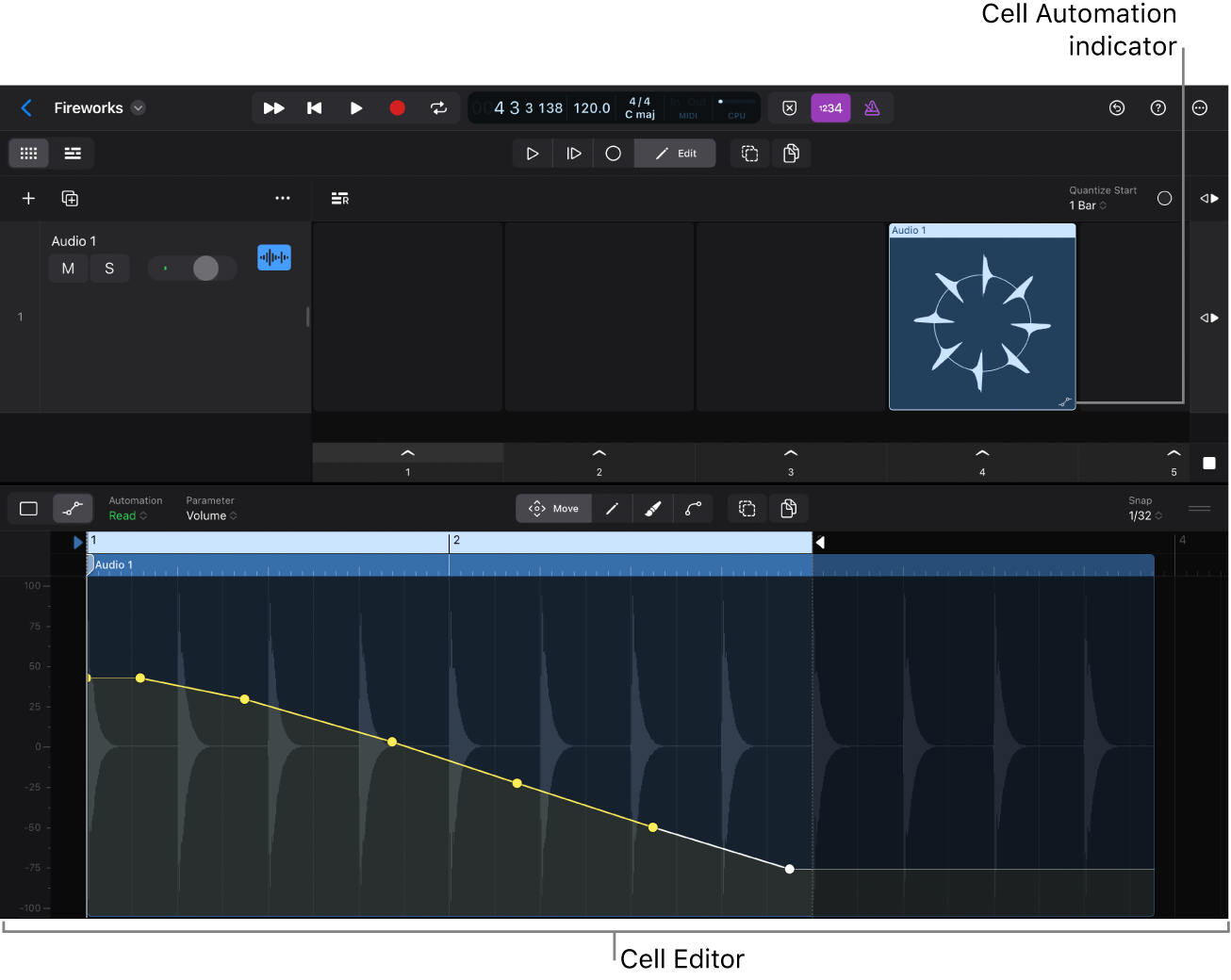Logic Pro User Guide for iPad
-
- What is Logic Pro?
- Working areas
- Work with function buttons
- Work with numeric values
-
- Intro to tracks
- Create tracks
- Create tracks using drag and drop
- Choose the default region type for a software instrument track
- Select tracks
- Duplicate tracks
- Reorder tracks
- Rename tracks
- Change track icons
- Change track colors
- Use the tuner on an audio track
- Show the output track in the Tracks area
- Delete tracks
- Edit track parameters
- Start a Logic Pro subscription
- How to get help
-
- Intro to recording
-
- Before recording software instruments
- Record software instruments
- Record additional software instrument takes
- Record to multiple software instrument tracks
- Record multiple MIDI devices to multiple tracks
- Record software instruments and audio simultaneously
- Merge software instrument recordings
- Spot erase software instrument recordings
- Replace software instrument recordings
- Capture your most recent MIDI performance
- Route MIDI internally to software instrument tracks
- Record with Low Latency Monitoring mode
- Use the metronome
- Use the count-in
-
- Intro to arranging
-
- Intro to regions
- Select regions
- Cut, copy, and paste regions
- Move regions
- Remove gaps between regions
- Delay region playback
- Trim regions
- Loop regions
- Repeat regions
- Mute regions
- Split and join regions
- Stretch regions
- Separate a MIDI region by note pitch
- Bounce regions in place
- Change the gain of audio regions
- Create regions in the Tracks area
- Convert a MIDI region to a Session Player region or a pattern region
- Rename regions
- Change the color of regions
- Delete regions
-
- Intro to chords
- Add and delete chords
- Select chords
- Cut, copy, and paste chords
- Move and resize chords
- Loop chords on the Chord track
- Edit chords
- Work with chord groups
- Use chord progressions
- Change the chord rhythm
- Choose which chords a Session Player region follows
- Analyze the key signature of a range of chords
- Create fades on audio regions
- Extract vocal and instrumental stems with Stem Splitter
- Access mixing functions using the Fader
-
- Intro to Step Sequencer
- Use Step Sequencer with Drum Machine Designer
- Record Step Sequencer patterns live
- Step record Step Sequencer patterns
- Load and save patterns
- Modify pattern playback
- Edit steps
- Edit rows
- Edit Step Sequencer pattern, row, and step settings in the inspector
- Customize Step Sequencer
-
- Effect plug-ins overview
-
- Instrument plug-ins overview
-
- ES2 overview
- Interface overview
-
- Modulation overview
- Use the Mod Pad
-
- Vector Envelope overview
- Use Vector Envelope points
- Use Vector Envelope solo and sustain points
- Set Vector Envelope segment times
- Vector Envelope XY pad controls
- Vector Envelope Actions menu
- Vector Envelope loop controls
- Vector Envelope point transition shapes
- Vector Envelope release phase behavior
- Use Vector Envelope time scaling
- Modulation source reference
- Via modulation source reference
-
- Sample Alchemy overview
- Interface overview
- Add source material
- Save a preset
- Edit mode
- Play modes
- Source overview
- Synthesis modes
- Granular controls
- Additive effects
- Additive effect controls
- Spectral effect
- Spectral effect controls
- Filter module
- Low, bandpass, and highpass filters
- Comb PM filter
- Downsampler filter
- FM filter
- Envelope generators
- Mod Matrix
- Modulation routing
- Motion mode
- Trim mode
- More menu
- Sampler
- Studio Piano
- Copyright
Automate cells in Live Loops in Logic Pro for iPad
Automation can also be created in cells when you work in the Live Loops grid. Cells are containers that include one or more regions of any of the four region types (audio region, MIDI region, Step Sequencer pattern region, or Session Player region). Adding and editing automation in cells is technically region automation for the region contained in the cell.
Selecting a cell and opening the Editors area shows the Cell Editor, which can have four different interfaces depending on the region type. It can be an Audio Editor, a Piano Roll Editor, a Step Sequencer, or a Session Player Editor, each one with some cell-specific controls. The Cell Editor also has the Automation View button to view and edit region automation.
Note: A cell that contains region automation shows the automation symbol ![]() in the lower-right corner of the cell (visible when zoomed in).
in the lower-right corner of the cell (visible when zoomed in).

Add cell automation
In the Tracks area menu bar, tap the Grid View button
 .
.Tap the Edit button
 in the Live Loops menu bar, then tap a cell to select it.
in the Live Loops menu bar, then tap a cell to select it.Tap the Editors button
 in the middle of the view control bar to open the Cell Editor.
in the middle of the view control bar to open the Cell Editor.The Cell Editor shows the user interface of the editor related to the region type. For example, if the cell contains a MIDI region, the Cell Editor will show the Piano Roll Editor.
Tap the Automation View button
 in the Editors area.
in the Editors area.The Cell Editor doesn’t have an Automation View button if it shows a pattern region.
Perform any of the graphical automation editing tasks.
Note: You can also write region automation in real time when you record to Live Loops cells.
Download this guide: PDF